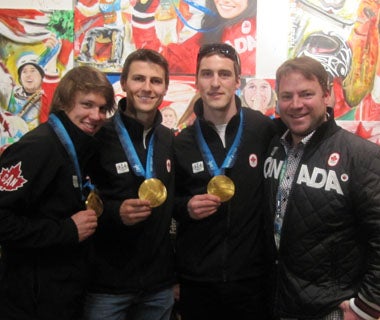
Waterloo alumus adds muscle to Canadian Olympic medical team
Kinesiology grad turned chiropractor is in Sochi working 18-hour days to prevent injuries and improve performance of Olympians

Kinesiology grad turned chiropractor is in Sochi working 18-hour days to prevent injuries and improve performance of Olympians
By Christian Aagaard Marketing and Strategic CommunicationsAs the world turns its eyes on Sochi, Richard Robinson is fixing his on the form and motion of Canadian Olympians.
Robinson’s skill in chiropractic medicine, primed by his kinesiology degree from the University of Waterloo (BSc. 1993), has earned him a spot on the support team for Canada’s athletes in the Russian city.
“I really like amateur sport,” says Robinson, director of chiropractic services for LifeMark Health in Calgary. "I really appreciate the genuineness of the athletes, the non-entitlement of the athletes. They are a pleasure to work with.’’
Fourth Olympics for Waterloo alumnus

Robinson (right) with members of the Canadian team at the 2010 Winter Olympics.
This is Robinson’s fourth Olympics: He accompanied Canadian teams to Vancouver in 2010, Beijing, China, in 2008 and Torino, Italy, in 2006.
He watches athletes train and compete at venues, confers with them at clinics and attends debriefing sessions with coaches and colleagues on the medical team. His typical Olympic work day stretches 18 hours.
Robinson is one of two chiropractors with the Canadian team in Sochi. A colleague looks after athletes competing in mountain sports, while he takes care of speed skaters, curlers, figure skaters and hockey players going for gold near the coast.
His focus, Robinson says, is not so much on treating injuries as preventing them, and offering advice that might improve an athlete’s performance by fractions of a second.
“I am so lucky because the best of the best in a given profession are going to be there,” Robinson says. “I learn so much each time I go.”
Injury treated by chiropractor inspired him to study kinesiology
Robinson had wanted to be a broadcast sports journalist when a wrenched knee knocked him off stride. “Nobody was able to fix my knee,” he says. "It kept bugging me and somebody suggested I go see a chiropractor.
“He did — in one visit — what nobody could do in five months. The problem wasn’t coming from my knee. It was coming from the biomechanics in my back.”
Impressed by that whole-body approach to injury and recovery, he set his sights on Canada’s best kinesiology program, and packed his bags for Waterloo.
Chiropractic medicine struggled for respect and acceptance in the health-care community 25 years ago. But attitudes were changing.
“The forward thinking of Waterloo was such that, by the time I left in the early 1990s, the word chiropractic was on the university calendar,” Robinson says. “They had a pre-chiropractic, pre-physio and a pre-medical stream in kinesiology.”
Today, his resumé lists numerous advisory roles with sport authorities in Canada, the United States and Australia. He is also clinical director of Calgary Sports Therapy.

Read more
Here are the people and events behind some of this year’s most compelling Waterloo stories

Read more
From pumpkin patches to haunting nightmares, a proud Waterloo alum shares how Snyder’s Farm evolved into one of Ontario’s final destinations for Halloween

Read more
Meet five exceptional Waterloo graduate students crossing the convocation stage as Class of 2025 valedictorians
The University of Waterloo acknowledges that much of our work takes place on the traditional territory of the Neutral, Anishinaabeg, and Haudenosaunee peoples. Our main campus is situated on the Haldimand Tract, the land granted to the Six Nations that includes six miles on each side of the Grand River. Our active work toward reconciliation takes place across our campuses through research, learning, teaching, and community building, and is co-ordinated within the Office of Indigenous Relations.